Trees of the Adirondacks:
Tamarack (Larix laricina)
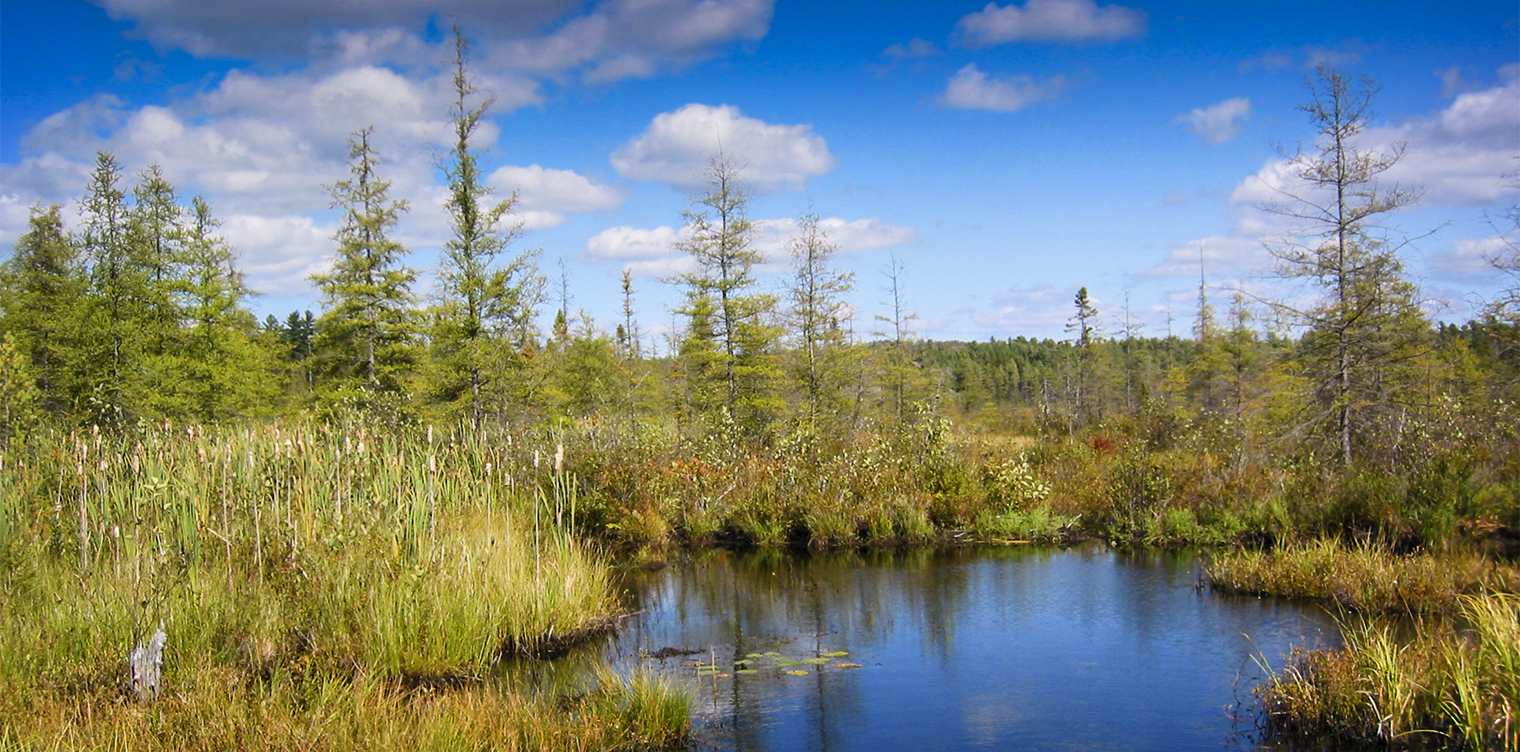
The Tamarack (Larix laricina) is a deciduous conifer which flourishes in the Adirondack Mountains of upstate New York, especially in wetlands. It is the only deciduous conifer native to the Adirondacks. It is a member of the Pine Family.
This species is also referred to as the American Larch, Eastern Larch, Alaska Larch, North American Black Larch, Tamarack Larch, and Hackmatack. Sources differ on the etymology of the latter name; most sources suggest that the name "Hackmatack" derives from the Abenaki word for a kind of supple wood used for making snowshoes.
Identification of the Tamarack
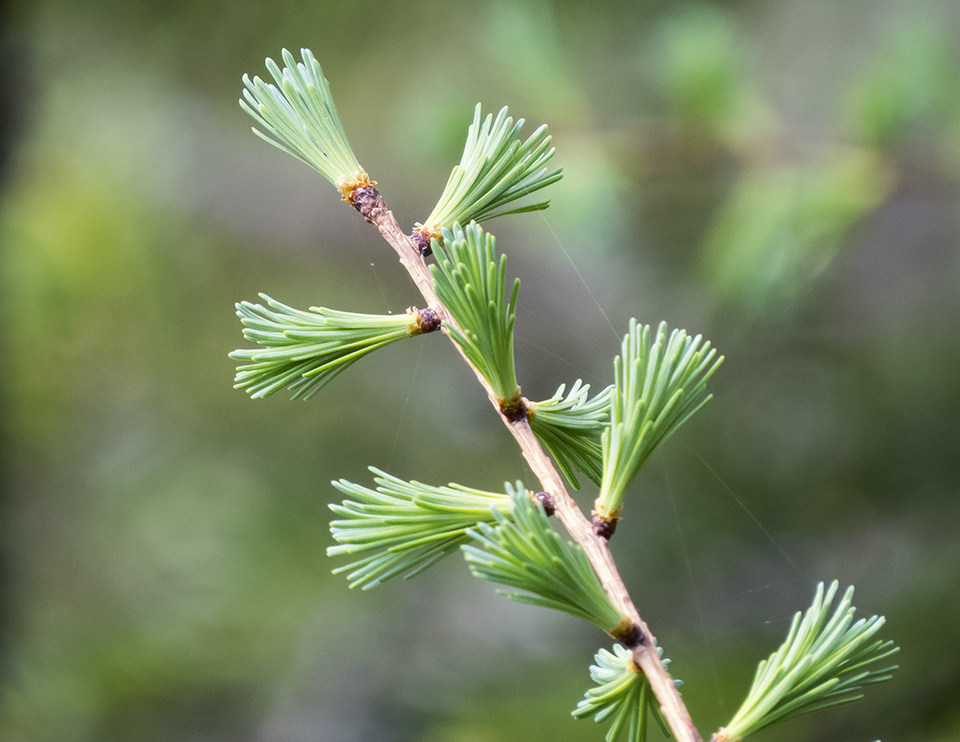
The Tamarack is a slender-trunked, conical, upright tree with a shallow root system. The average height of mature Tamaracks is 50 to 75 feet. However, most Tamaracks growing in bogs and marshes are much smaller, due to the low nutrients available in these locations. Tamaracks growing in peat-lands grow very slowly. A tree that stands only six feet tall may be over a half-century old.
The Tamarack has flattened green needles, about one inch long, arranged in clusters of ten to twenty. They are attached to the twigs in tight spirals around short spur branches, giving the tree a feathery look.
In contrast to most conifers, which retain their needles all year around, the Tamarack sheds its needles every year in the fall. The glossy needles appear in soft tufts in spring and are initially apple green in color, changing to blue-green as the season progresses. In late summer and early fall, the needles gradually change color, first to a greenish-yellow. The needles then gradually change to a brilliant orange before they are shed. In our region, most Tamaracks begin the color change in early October, with peak color in late October after most of the hardwoods have dropped their leaves.
The bark of a young Tamarack is grayish to reddish brown with thin, irregular scales. As the tree matures, the bark becomes grayer. The inner layer is red-purple. The branches are horizontal or slightly ascending. The twigs are orange-brown. The buds are dark red. The seed cones are small (0.5 to 0.75 inches long), with lustrous brown scales. They are bright red, turning brown and opening to release seeds when mature. Cones remain on the trees for two to five years.
Uses of the Tamarack
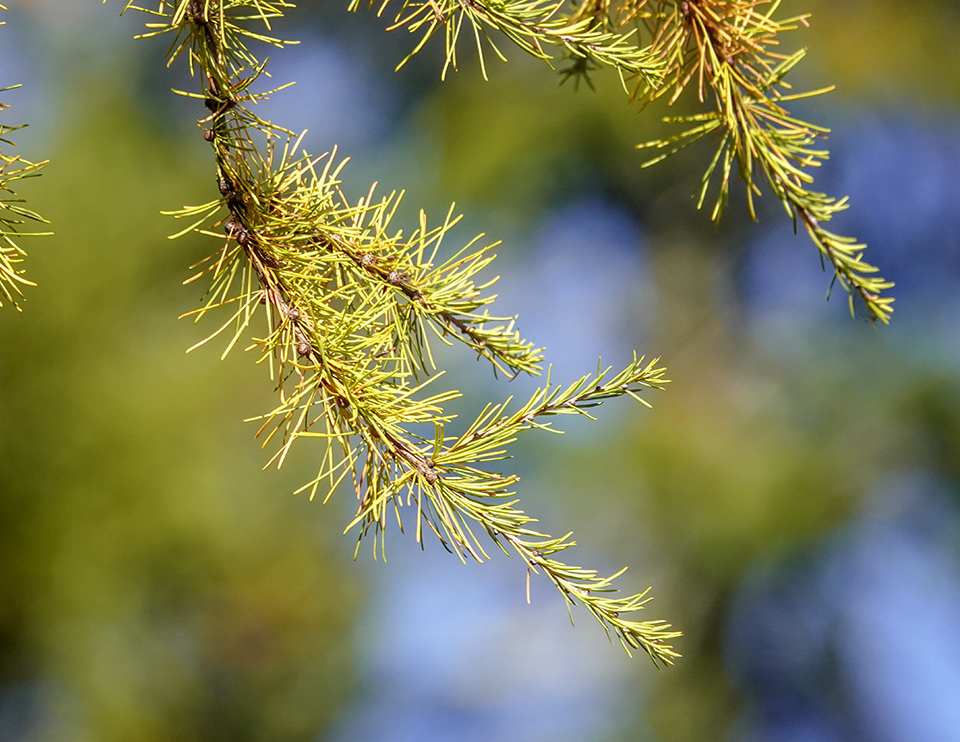
Tamarack is not a major commercial timber species, due to insect and disease problems. The wood is used mainly for pulpwood, especially in making the transparent paper in window envelopes. Because the wood is relatively rot-resistant, it is also used for posts, poles, mine timbers, and railroad ties.
Tamarack is also used in other wood products, including rough lumber, boxes, crates, boats, and fuel wood. Tamarack bark contains a tannin which has been used for tanning leather. In Alaska, young Tamarack stems have been employed to make dog sled runners, boat ribs, and fish traps. In earlier periods, native Americans used the fine roots of the Tamarack to sew birch bark and the wood to make arrow shafts. Early settlers used the needles for stuffing pillow and mattresses.
The plant has limited edible uses for humans. The needles are said to be edible and can be used to make tea. Tea can also be made from the roots. The tender new shoots of the Tamarack reportedly can be boiled and eaten in an emergency.
This plant reportedly was employed medicinally by many native American groups. For example, the Abnaki reportedly used an infusion of the bark and roots for persistent coughs. The Algonquin made a cough medicine of its needles and inner park. They also applied a poultice of the needles and inner bark to infections and made an infusion of its young branches as a laxative. The Chippewa used a poultice of chopped inner bark to treat burns.
Wildlife Value of the Tamarack
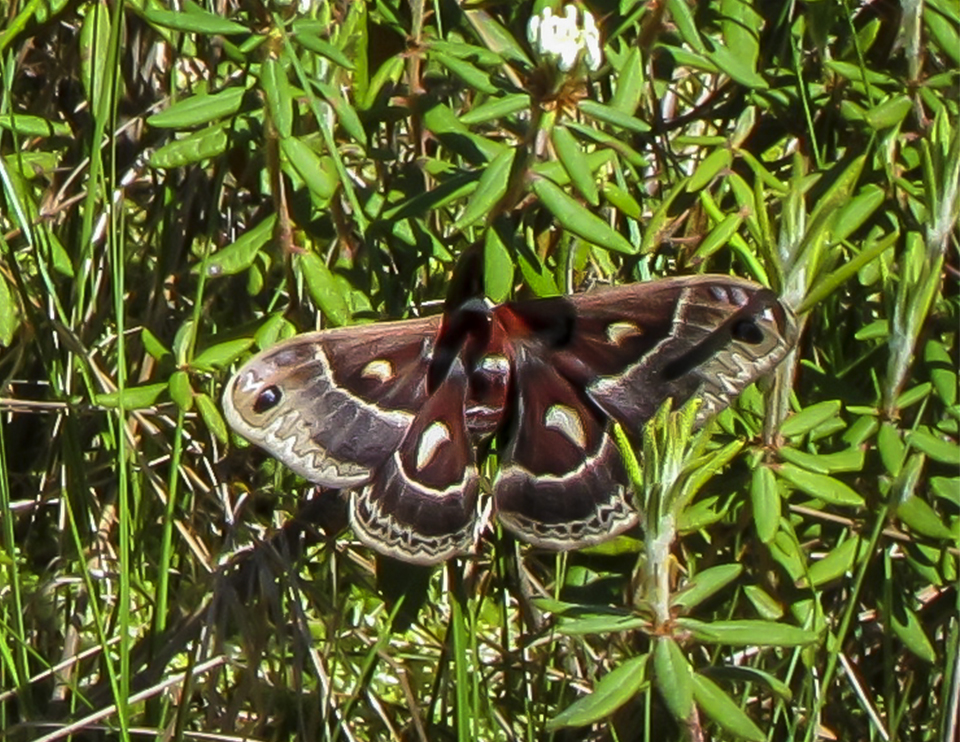
The Tamarack is not a major wildlife food source. It is browsed by a number of species, but does not form a major component of their diets. Snowshoe Hares are known to browse on Tamarack bark and seedlings. Porcupines sometimes feed on the inner bark. Red Squirrels eat the seeds. Moose and White-tailed Deer generally avoid Tamarack. White-tailed Deer will eat it only when more nourishing browse is lacking. Because this species sheds its needles in winter, it is of limited value as cover.
A number of insects are known to feed on this tree. The Tamarack is a larval host for the Columbia Silkmoth. In fact, the Columbia Silkmoth larva is known as the Larch Silkworm. The Tamarack is also the host plant for the Eye-spotted Bud Moth, Poecila Sphinx, Northern Pine Sphinx, Apple Sphinx, and Pine Measuringworm Moth. Several bark beetles feed on the bark.
Larch Sawflies can also infest Tamaracks, attracting many birds, such as White-throated Sparrows, Common Yellowthroats, and Nashville Warblers, who feed on both the larval and adult sawflies. The seeds of the Tamarack are eaten by Pine Siskins. The needles and buds are eaten by Spruce Grouse and Ruffed Grouse.
In addition, a number of birds use Tamaracks as a nesting site. These include:
Distribution of the Tamarack
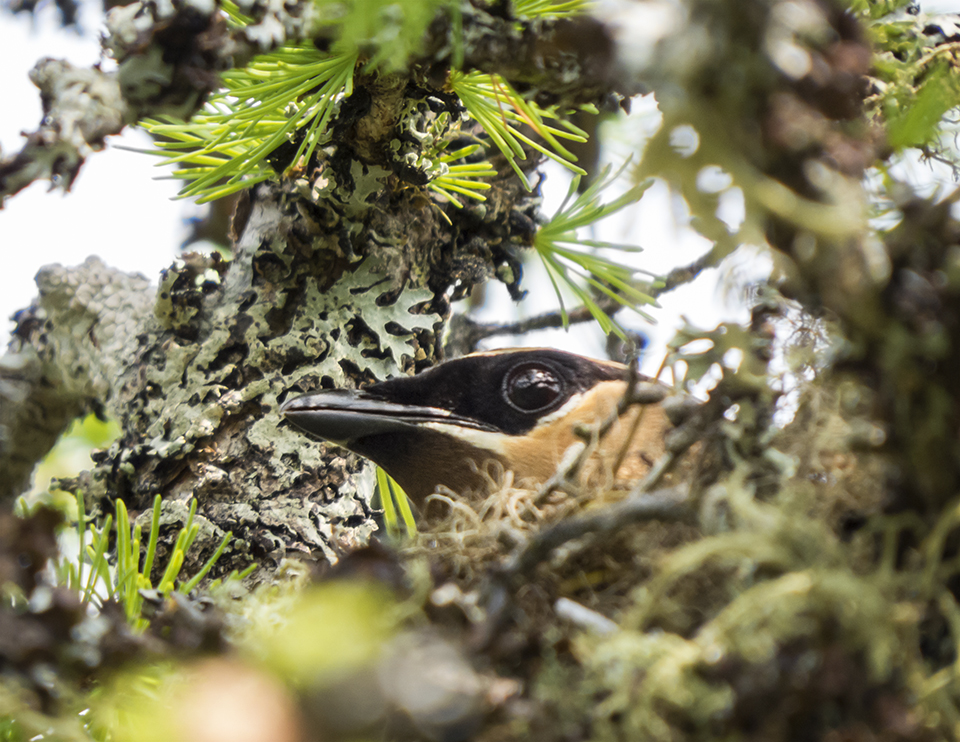
The Tamarack is a northern species. Its range extends from Newfoundland and Labrador in Canada, west across the Continental Divide to the northern Yukon. In the US, the Tamarack is confined mainly to the northeastern states, including Maine, Vermont, New Hampshire, Massachusetts, Minnesota, and Wisconsin.
In New York State, Tamaracks are present in most counties in the eastern half of the state. Vouchered plant specimens of this species have been documented for all counties within the Adirondack Park Blue Line, with the exception of Clinton County.
Habitat of the Tamarack
Tamaracks can tolerate a wide range of soil conditions. They can grow on well-drained outwash sands, well-drained tills, and poorly drained sites. They can survive on nutrient-poor, acid peatlands. The Tamarack is one of the most cold-hardy native trees. However, this species is intolerant of shade, heat, and polluted areas. Tamaracks are out-competed on better sites where other species crowd them out.
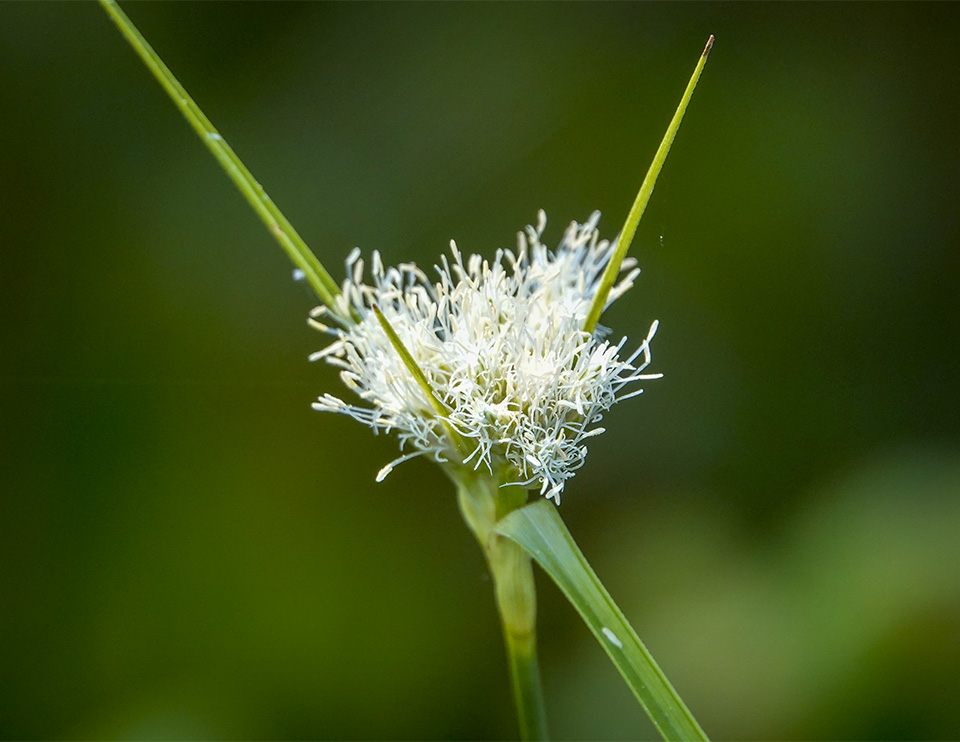
For this reason, Tamaracks are most commonly found on cold, wet to moist, poorly drained sites, such as swamps and bogs. These trees also grow along streams, lakes, ponds, swamps, and occasionally on upland sites. The Tamarack's abundance on saturated soils is due to the fact that these sites are unfavorable for growth of most other trees.
The Tamarack is a pioneer species, colonizing sites severely disturbed by fire or moving into abandoned fields. For instance, Tamaracks can be seen on the edges of the Old Orchard at Heaven Hill, where they have colonized parts of the orchard that have not been mowed for many years. Another example of Tamarack's ability to capitalize on disturbance is at the Forest Ecosystem Research and Demonstration Area at the Paul Smith's College VIC, where Tamarack could be seen in the clear cut block a decade after logging. Because the Tamarack is so shade-intolerant, it will be out-competed in later stages of succession.
Tamaracks are found in a wide variety of ecological communities in the Adirondack Park:
- Alpine Krummholz
- Alpine Sliding Fen
- Black Spruce Tamarack Bog
- Boreal Heath Barrens
- Dwarf Shrub Bog
- Highbush Blueberry Bog Thicket
- Inland Poor Fen
- Northern White Cedar Swamp
- Oxbow Lake/Pond
- Patterned Peatland
- Red Maple-Tamarack Peat Swamp
- Rich Graminoid Fen
- Rich Hemlock-Hardwood Peat Swamp
- Rich Shrub Fen
- Spruce Flats
- Spruce-Fir Swamp
In the Adirondacks, Tamaracks can be seen on fairly well-drained soils, such as well-drained tills once cleared for field and then abandoned. However, these trees are most commonly found in marshes and bogs. In marshes, Tamaracks flourish on the drier edges, together with shrubs such as Leatherleaf, White Meadowsweet, Steeplebush, and Sheep Laurel. These transitional areas along marsh edges are home to a wide variety of birds, such as the Common Yellowthroat and the Black-capped Chickadee.
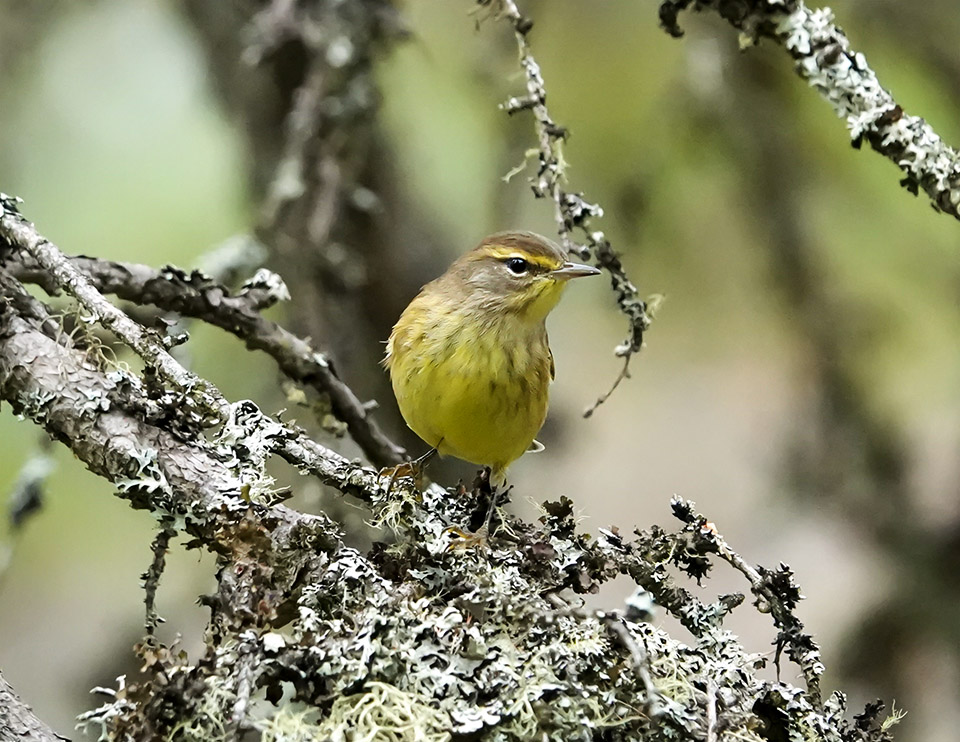
In Adirondack bogs, Tamaracks co-exist with Black Spruce and a host of bog-dwelling shrubs, such as Sheep Laurel, Bog Laurel, Leatherleaf, Bog Rosemary, and Labrador Tea. Plants which thrive in the sphagnum moss of bogs include Roundleaf Sundew, Pitcher Plant, Marsh Cinquefoil, Buckbean, Rose Pogonia, Cottongrass, Little Club-spur Orchid, and White-fringed Orchid.
Bogs that host Tamaracks are a good place to find a variety of wetland-dwelling birds.
- Several species of birds are often seen perching on or near the Tamaracks in bogs or on the edges of bogs, including Yellow-bellied Flycatchers, Cedar Waxwings, and Yellow-rumped Warblers.
- Several boreal bird species nest in bogs, including Palm Warblers and Lincoln's Sparrows.
The Boreal Life Trail boardwalk, providing access to Barnum Bog, is the best place to observe Tamaracks growing on a boreal bog. Tamaracks can also be found on Bloomingdale Bog.
Adirondack Tree List
References
Michael Kudish. Adirondack Upland Flora: An Ecological Perspective (Saranac, New York: The Chauncy Press, 1992), p. 90-91.
E. H. Ketchledge. Forests and Trees of the Adirondack High Peaks Region (Adirondack Mountain Club, 1996), pp. 66-70.
New York Flora Association. New York Flora Atlas. Larix laricina. Retrieved 24 October 2022.
United States Department of Agriculture. The Plants Database. Tamarack. Larix laricina. Retrieved 24 October 2022.
United States Department of Agriculture. NRCS National Plant Data Center & the Biota of North America Program. Plant Guide. Tamarack. Larix laricina (Du Roi) K. Koch. Retrieved 24 October 2022.
United States Department of Agriculture. Forest Service. Silvics of North America. Larix laricina (Du Roi) K. Koch. Retrieved 18 December 2020.
United States Department of Agriculture. Fire Effects Information System (FEIS). Species Reviews. Larix laricina. Retrieved 24 October 2022.
H. A. Fowells. Silvics of Forest Trees of the United States (U.S. Department of Agriculture, Agriculture Handbook 271, 1965), pp. 227-234. Retrieved 24 October 2022.
Flora of North America. Larix laricina (Du Roi) K. Koch. Retrieved 24 February 2017.
Lady Bird Johnson Wildflower Center. Native Plant Database. Retrieved 11 January 2015.
Flora of Wisconsin. Larix laricina. Retrieved 11 January 2015.
Online Encyclopedia of Life. Larix laricina. Retrieved 11 January 2015.
iNaturalist. Scientific Tamarack. Larix laricina. Retrieved 2 April 2021.
iNaturalist. Adirondack Park Sightings. Tamarack. Larix laricina. Retrieved 24 October 2022.
William K. Chapman and Alan E. Bessette. Trees and Shrubs of the Adirondacks: A Field Guide (North Country Books, 1990), p. 20, Plate 3.
Stan Tekiela. Trees of New York: Field Guide (Adventure Publications, Inc., 2006), pp. 30-31.
Michael Wojtech. Bark: A Field Guide to Trees of the Northeast (University Press of New England, 2011), pp. 182-183.
Native Plant Trust. Go Botany. American Larch. Larix laricina. Retrieved 24 October 2022.
New York State. Department of Environmental Conservation. New York Natural Heritage Program. Ecological Communities of New York State. Second Edition (March 2014), pp. 58-59, 60-61, 63-64, 72, 75, 76, 102, 104-105, 122. Retrieved 17 October 2015.
New York Natural Heritage Program. 2022. Online Conservation Guide for Alpine Krummholz. Retrieved 24 October 2022.
New York Natural Heritage Program. 2022. Online Conservation Guide for Alpine Sliding Fen. Retrieved 24 October 2022.
New York Natural Heritage Program. 2022. Online Conservation Guide for Black Spruce-Tamarack Bog. Retrieved 24 October 2022.
New York Natural Heritage Program. 2022. Online Conservation Guide for Boreal Heath Barrens. Retrieved 24 October 2022.
New York Natural Heritage Program. 2022. Online Conservation Guide for Dwarf Shrub Bog. Retrieved 24 October 2022.
New York Natural Heritage Program. 2022. Online Conservation Guide for Highbush Blueberry Bog Thicket. Retrieved 24 October 2022..
New York Natural Heritage Program. 2019. Online Conservation Guide for Inland Poor Fen. Retrieved 24 October 2022.
New York Natural Heritage Program. 2022. Online Conservation Guide for Northern White Cedar Swamp. Retrieved 24 October 2022.
New York Natural Heritage Program. 2022. Online Conservation Guide for Oxbow Lake/Pond. Retrieved 24 October 2022.
New York Natural Heritage Program. 2022. Online Conservation Guide for Patterned Peatland. Retrieved 24 October 2022..
New York Natural Heritage Program. 2022. Online Conservation Guide for Red Maple-Tamarack Peat Swamp. Retrieved 24 October 2022.
New York Natural Heritage Program. 2022. Online Conservation Guide for Rich Graminoid Fen. Retrieved 24 October 2022.
New York Natural Heritage Program. 2022. Online Conservation Guide for Rich Hemlock-Hardwood Peat Swamp. Retrieved 24 October 2022..
New York Natural Heritage Program. 2022. Online Conservation Guide for Rich Shrub Fen. Retrieved 24 October 2022.
New York Natural Heritage Program. 2022. Online Conservation Guide for Spruce Flats. Retrieved 24 October 2022.
New York Natural Heritage Program. 2022. Online Conservation Guide for Spruce-Fir Swamp. Retrieved 24 October 2022.
New York State. Adirondack Park Agency. Preliminary List of Species Native Within the Adirondack Park Listed Alphabetically by Scientific Name and Sorted by Habit. Volume 1. Updated 10.23.2006. Retrieved 26 January 2017.
Mark J. Twery, et al. Changes in Abundance of Vascular Plants under Varying Silvicultural Systems at the Forest Ecosystem Research and Demonstration Area, Paul Smiths, New York. USDA Forest Service. Research Note NRS-169. Retrieved 22 January 2017.
Alexander C. Martin, Herbert S. Zim, and Arnold L. Nelson. American Wildlife & Plants. A Guide to Wildlife Food Habits (New York: Dover Publications, 1951), pp. 289-290. Retrieved 24 October 2022.
John Eastman. The Book of Swamp and Bog: Trees, Shrubs, and Wildflowers of Eastern Freshwater Wetlands (Stackpole Books, 1995), pp. 188-193.
University of Michigan. Native American Ethnobotany. A Database of Foods, Drugs, Dyes and Fibers of Native American Peoples, Derived from Plants. Larix laricina (Du Roi) K. Koch. Retrieved 24 October 2022.
Steven Foster and James A. Duke. Medicinal Plants and Herbs of Eastern and Central North America (Houghton Mifflin Harcourt, 2014), pp. 339-340.
Plants for a Future. Larix laricina - (Du Roi.) K. Koch. Retrieved 24 October 2022.
Online Etymology Dictionary. Tamarack. Retrieved 12 January 2015.
The Birds of North America. Ruby-crowned Kinglet; Palm Warbler; Lincoln's Sparrow; Black-backed Woodpecker; Nashville Warbler; Alder Flycatcher. Subscription Web Site. Retrieved 12 January 2015.
Butterflies and Moths of North America. Columbia silkmoth, Poecila sphinx, Northern pine sphinx, Apple sphinx, Pine Measuringworm Moth, Retrieved 25 February 2017.
Iowa State University. BugGuide. Columbia Silkmoth and Eye-spotted Bud Moth. Retrieved 24 February 2017.
George A. Petrides. A Field Guide to Eastern Trees (Boston: Houghton Mifflin Company, 1998), pp. 34-35, 157. Retrieved 24 October 2022.
John Kricher. A Field Guide to Eastern Forests. North America (Boston: Houghton Mifflin, 1998), pp. 62-70, 122. Retrieved 24 October 2022.
